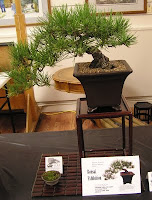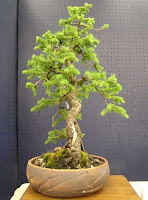

A well arranged display of several fine bonsai and a steady stream of visitors made for a notable July exhibit from the Akron Canton Bonsai Society. There really is nothing like the annual show to get the creative juices flowing. It really is quite exciting to see each other's trees and how they have progressed this season over last.
Several member trees have now reached a point of refinement that they can be rightly considered specimen trees.
Among the highlights were Dan's (our club president) two amazing junipers which were created from shrubbery that was discarded from a city park several years ago. both are quite large in size and are highlighted with sections of dead wood. These two bonsai get better every year, and it is always exciting to see them. There were also several pine projects, such as Gib's small cascade black pine that was pictured on our show card this time, and some fine scotch pine projects. Mike's 80 year old concord grape has a different look every year, and had three grape clusters for this years show. There were also examples of neatly developed elms, box woods, yews, spruce, and tropicals in the exhibit.
Pictures of the entire exhibit can be seen at our gallery site:
http://picasaweb.google.com/akroncantonbonsai












